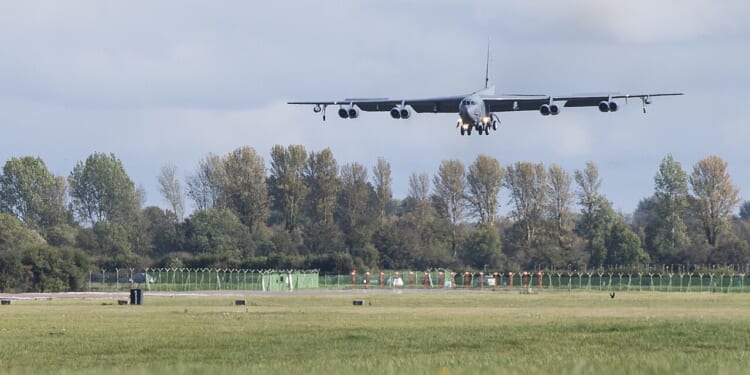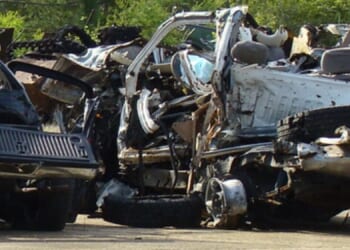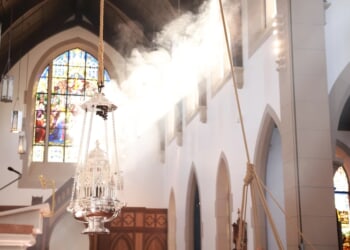There are currently 76 B-52s in the US Air Force fleet—and many of these graduates are young enough to be the grandchildren of the original pilots of those aircraft.
In the past month, college students across the United States have returned to their studies, but at Louisiana’s B-52 “Formal Training Unit” (FTU), a new class has just graduated. The B-52 flight school, located at Barksdale Air Force Base (AFB), Louisiana, is the only facility in the country that trains aircrews for the Boeing B-52 Stratofortress.
A second set of aviators has now completed their training to operate the long-range strategic bomber this year.
“We’re potentially the most dangerous and destructive aircraft on the planet, and our graduates are taking the torch, moving it forward and up along the field,” said Lt. Col. Millard Matthews III, 93rd Bomb Squadron commander, during his address to the graduates at their graduation ceremony on September 12, 2025. “And we couldn’t do it without our Total Force brethren.”
How to Learn to Fly a B-52
The B-52 FTU was established in March 2009, in collaboration with the US Air Force Reserve’s 93rd Bomb Squadron and the active-duty 11th Bomb Squadron, to conduct all formal training on the B-52. Formal training lasts from eight to 11 months, which includes four to five months of academic training followed by practical flight experience in the Cold War-era bomber that remains the workhorse for the US Air Force.
“The biggest lesson I’ve learned is the importance of being able to rely on the other members of the crew,” said 1st Lt. Colin McDonough, an FTU student assigned to the 11th Bomb Squadron. “There were times we made mistakes, but we got better as the flight line progressed, and by the end, we were able to catch those mistakes and not make them.”
Each class can consist of approximately 30 new B-52 aircrews to maintain a steady pipeline of initial, upgrade, and requalification candidates who can operate the long-range bomber.
Next Up: The B-52’s “Striker STEEL” Exercises
Aviators at the FTU will participate in Striker STEEL (Strategically Enhancing Effective Long-Range Strike), a human-performance program that was tailored explicitly for B-52 crew training. Crews focus on skills including memory training and quick problem-solving to help provide aircrews with a mental edge during combat missions.
“When we first started [Striker STEEL], they made the expectations very clear – ‘we’re not going to turn you guys into super soldiers here,’” said McDonough. “The idea is that you’re going to be one to three percent better from a cognitive standpoint, which could give you the edge one day down the line.”
Striker STEEL is also part of the larger Common Re-evaluation, Re-tooling, and Re-engineering (CRAFT) program, which focuses on advanced training and education for B-52 aircrews. As the US Air Force Global Strike Command (AFSTRAT-AIR) previously noted, CRAFT isn’t about improving the metal, electronics, or other features of the B-52. That is already being addressed, and the bombers continue to be steadily upgraded.
Instead, the exercise is meant to hone the muscles, neurons, and the physical power of the aircrews’ bodies. The program was developed via a partnership with the Louisiana State Health Department in Shreveport via a Cooperative Research and Development Agreement.
“Together, they created a mutually beneficial relationship with the local Shreveport and Bossier City community, working to provide advanced equipment, specialists, and other resources to enhance the immediate capability and long-term capacity of local bomber aviators,” AFSTRAT-Air explained.
The program is the culmination of more than two years of study aimed at determining what bomber pilots could do better.
“Global Strike CRAFT understands that there are many aspects of performance and well-being including physical, nutritional, and psychological components,” explained Dr. Tucker Readdy, operations director and chief scientist of AFGSC CRAFT. “Teaching and training for aircrew is approached in a multi-disciplinary manner that emphasizes the inter relationship between these elements.”
B-52 Pilots Never Stop Training
FTU is the first step, but far from the last. Graduates who have completed their initial pilot training and who have graduated from the FTU will join an operational squadron, where they will undergo further training to prepare them for future missions with the Stratofortress.
“You’re finishing up here, you’ve completed your training aspect, you’ve learned a little bit about the mission, and your next milestones are to become combat-mission ready,” added Lt. Colonel James Bresnahan, commander of the 11th Bomb Squadron, to the assembled FTU graduates. “So, off you go to your operational squadrons, where they bring you up with the latest additional tactical skills and what it takes to be part of a combat crew.”
There are currently 76 B-52s in the US Air Force fleet—and many of these graduates are young enough to be the grandchildren of the original pilots of those aircraft. Thanks to the new training and a focus on improving pilot skills, the remaining Stratofortress bombers are likely to remain in good hands.
About the Author: Peter Suciu
Peter Suciu has contributed over 3,200 published pieces to more than four dozen magazines and websites over a 30-year career in journalism. He regularly writes about military hardware, firearms history, cybersecurity, politics, and international affairs. Peter is also a contributing writer for Forbes and Clearance Jobs. He is based in Michigan. You can follow him on Twitter: @PeterSuciu. You can email the author: [email protected].
Image: Wikimedia Commons.

















